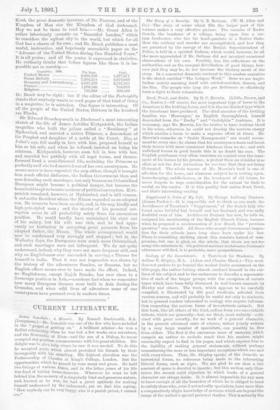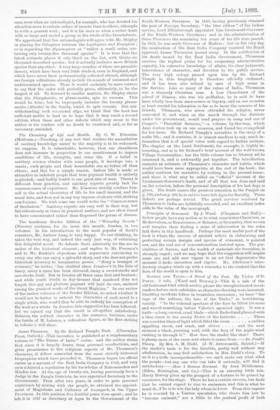Zoology of the Invertebrate. A Text-book for Students. By Arthur
E. Shipley, M.A.. (Adam and Charles Black.)—This work does not profess to go beyond the modest limits announced on the title-page, the author having almost confined himself to the out- lines of his subject and to the endeavour to describe a representa- tive of each of the larger groups, with the exception of certain types which have been fully discussed in well-known manuals by Huxley and others. The work, which appears to be carefully compiled, is illustrated by 263 good woodcuts, selected from various sources, and will probably be useful not only to students, but to general readers interested in zoology who require informa- tion respecting the various forms of invertebrate animals. But this book, like all others of the kind, suffers from two unavoidable defects, which are generally—but, we think, most unfairly—criti- cised with great severity, for no work of a general character, in the present advanced state of science, unless jointly written by a very large number of specialists, can possibly be free from either. The first is the enormous mass of material, which compels an author to exclude much that his readers might reasonably expect to find in his pages, and which exposes him to the liability of making general statements without perhaps remembering the more or less important exceptions which are met with everywhere. Thus, Mr. Shipley speaks of the Oniscidle as terrestrial forms, no reference being made to the interesting littoral forms, such as Ligia. We are glad to see that a, fair amount of space is devoted to insects; but this section only illus- trates the second valid objection to which books of a general character are always liable. It is almost impossible for any man to know enough of all the branches of which he is obliged to treat to satisfy those who, even if not actually specialists, have more than a comparatively slight knowledge of sections which are beyond the range of the author's special personal studies. This is actually the case, even when an entomologist, for example, who has devoted his attention more to certain orders of insects than to others, attempts to write a general work ; and it is far more so when a writer deals with so large and varied a group as the whole of the Invertebrate,. We apprehend that few entomologists will agree with Mr. Shipley in placing the Coleoptera between the Lepidoptera and Hemiptera ; or in regarding the Hymenoptera as "rather a small order, con- taining only twenty-five thousand species." It is true that the latest estimate places it only third on the list, with thirty-six thousand described species ; but it actually includes more British species than any other. A very large number of these are parasitic insects, which have been very little studied, even in England, and which have never been systematically collected abroad, although our foreign collections already include thousands of unnamed and undetermined species. Thus it would certainly be more correct to say that the order will probably prove, ultimately, to be the largest of all. To descend to smaller matters, Mr. Shipley states that the Pterophoriclw, or plume-moths, spin no cocoons. This would be true ; but he improperly includes the twenty plume- moths (ANcita) in the family, which do spin cocoons. But not- withstanding such occasional slips, we think that the book has sufficient merits to lead us to hope that it may reach a second edition, when these and other defects which may occur to the author or his readers will no doubt be examined and, as far as necessary, amended.











































 Previous page
Previous page